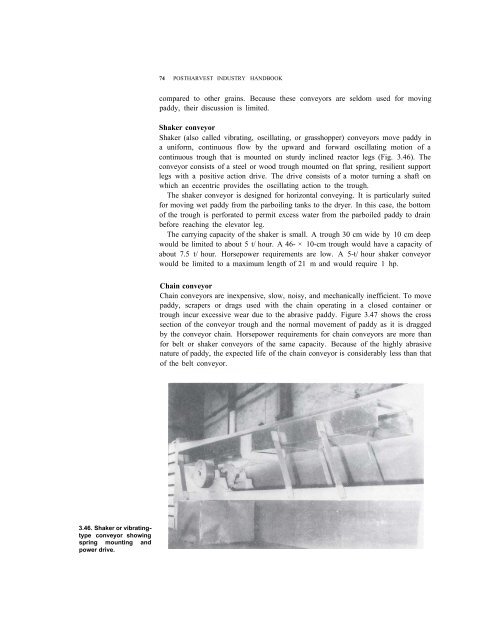Technical handbook for the paddy rice postharvest industry in ...
Technical handbook for the paddy rice postharvest industry in ...
Technical handbook for the paddy rice postharvest industry in ...
You also want an ePaper? Increase the reach of your titles
YUMPU automatically turns print PDFs into web optimized ePapers that Google loves.
74 POSTHARVEST INDUSTRY HANDBOOKcompared to o<strong>the</strong>r gra<strong>in</strong>s. Because <strong>the</strong>se conveyors are seldom used <strong>for</strong> mov<strong>in</strong>g<strong>paddy</strong>, <strong>the</strong>ir discussion is limited.Shaker conveyorShaker (also called vibrat<strong>in</strong>g, oscillat<strong>in</strong>g, or grasshopper) conveyors move <strong>paddy</strong> <strong>in</strong>a uni<strong>for</strong>m, cont<strong>in</strong>uous flow by <strong>the</strong> upward and <strong>for</strong>ward oscillat<strong>in</strong>g motion of acont<strong>in</strong>uous trough that is mounted on sturdy <strong>in</strong>cl<strong>in</strong>ed reactor legs (Fig. 3.46). Theconveyor consists of a steel or wood trough mounted on flat spr<strong>in</strong>g, resilient supportlegs with a positive action drive. The drive consists of a motor turn<strong>in</strong>g a shaft onwhich an eccentric provides <strong>the</strong> oscillat<strong>in</strong>g action to <strong>the</strong> trough.The shaker conveyor is designed <strong>for</strong> horizontal convey<strong>in</strong>g. It is particularly suited<strong>for</strong> mov<strong>in</strong>g wet <strong>paddy</strong> from <strong>the</strong> parboil<strong>in</strong>g tanks to <strong>the</strong> dryer. In this case, <strong>the</strong> bottomof <strong>the</strong> trough is per<strong>for</strong>ated to permit excess water from <strong>the</strong> parboiled <strong>paddy</strong> to dra<strong>in</strong>be<strong>for</strong>e reach<strong>in</strong>g <strong>the</strong> elevator leg.The carry<strong>in</strong>g capacity of <strong>the</strong> shaker is small. A trough 30 cm wide by 10 cm deepwould be limited to about 5 t/ hour. A 46- × 10-cm trough would have a capacity ofabout 7.5 t/ hour. Horsepower requirements are low. A 5-t/ hour shaker conveyorwould be limited to a maximum length of 21 m and would require 1 hp.Cha<strong>in</strong> conveyorCha<strong>in</strong> conveyors are <strong>in</strong>expensive, slow, noisy, and mechanically <strong>in</strong>efficient. To move<strong>paddy</strong>, scrapers or drags used with <strong>the</strong> cha<strong>in</strong> operat<strong>in</strong>g <strong>in</strong> a closed conta<strong>in</strong>er ortrough <strong>in</strong>cur excessive wear due to <strong>the</strong> abrasive <strong>paddy</strong>. Figure 3.47 shows <strong>the</strong> crosssection of <strong>the</strong> conveyor trough and <strong>the</strong> normal movement of <strong>paddy</strong> as it is draggedby <strong>the</strong> conveyor cha<strong>in</strong>. Horsepower requirements <strong>for</strong> cha<strong>in</strong> conveyors are more than<strong>for</strong> belt or shaker conveyors of <strong>the</strong> same capacity. Because of <strong>the</strong> highly abrasivenature of <strong>paddy</strong>, <strong>the</strong> expected life of <strong>the</strong> cha<strong>in</strong> conveyor is considerably less than thatof <strong>the</strong> belt conveyor.3.46. Shaker or vibrat<strong>in</strong>gtypeconveyor show<strong>in</strong>gspr<strong>in</strong>g mount<strong>in</strong>g andpower drive.




![MNC_00_Modau [Compatibility Mode].pdf](https://img.yumpu.com/51432208/1/190x146/mnc-00-modau-compatibility-modepdf.jpg?quality=85)











